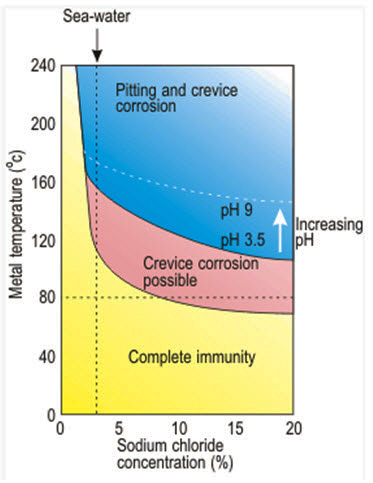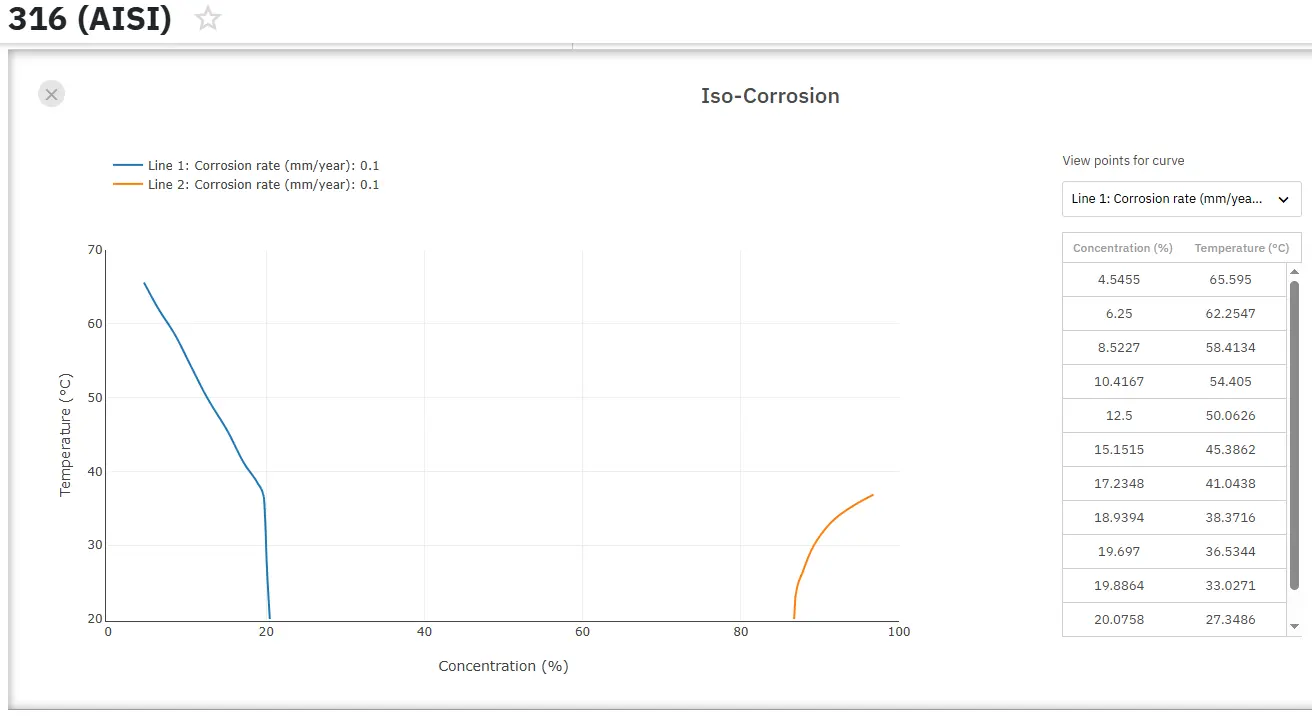Corrosion of Titanium Alloys: Part Two
Abstract
Titanium alloys demonstrate exceptional corrosion resistance in most environments, but specific corrosion mechanisms can still affect their performance under certain conditions. This article examines four primary corrosion concerns for titanium alloys: erosion corrosion, stress corrosion cracking, corrosion fatigue, and crevice corrosion. Titanium exhibits outstanding resistance to erosion in high-velocity seawater up to 120 ft/sec and maintains excellent stress corrosion cracking resistance in hot chloride solutions. Unlike many materials, titanium does not suffer significant fatigue property loss in seawater environments. However, crevice corrosion remains the limiting factor for titanium applications in chemical processing and seawater desalination, typically occurring above 80°C in concentrated brines with low pH values. Understanding these corrosion mechanisms is essential for proper titanium alloy selection and application design.
Introduction to Titanium Alloy Corrosion Resistance
Titanium alloys have earned recognition for their exceptional corrosion resistance across a wide range of environments. However, this outstanding performance does not render these materials infallible, and engineers must understand the specific conditions where titanium alloys may exhibit susceptibility to corrosive attack. The primary corrosion mechanisms that require consideration when working with titanium alloys include erosion corrosion, stress corrosion cracking, corrosion fatigue, and crevice corrosion.
Each of these corrosion mechanisms presents unique challenges and occurs under specific environmental conditions. Understanding these mechanisms enables engineers to make informed decisions about titanium alloy selection and application design, ensuring optimal performance and longevity in demanding service environments.
Erosion Corrosion Resistance in Titanium Alloys
High-Velocity Seawater Performance
Titanium demonstrates remarkable ability to resist erosion corrosion in high-velocity seawater applications. This resistance extends to velocities as high as 120 feet per second, where only minimal increases in erosion rate occur. The presence of abrasive particles, such as sand, has only a small effect on the corrosion resistance of titanium under conditions that prove extremely detrimental to copper and aluminum-based alloys.
The exceptional performance of titanium in erosive environments has established it as one of the best cavitation-resistant materials available for seawater service. This characteristic makes titanium alloys particularly valuable in marine applications where high fluid velocities and abrasive conditions are common.
Specific Alloy Performance
Ti-3-2.5 alloy demonstrates excellent resistance to erosion in flowing seawater environments. Testing has shown that commercially pure titanium maintains its resistance to erosion at velocities up to 131 feet per second (40 meters per second), even with 15 grams per liter of sand particles present in the flow stream.
Extended testing of Ti-3-2.5 samples revealed no signs of corrosion after 30 days of exposure in 320°F (160°C) flowing seawater with a flow rate of 10.2 feet per second (3.1 meters per second). These results demonstrate the exceptional durability of titanium alloys in demanding erosive environments.
Table 1. Corrosion Rate of Titanium Grade 2 Ti, showing quantitative data on corrosion performance under various conditions
| Seawater Flow Rate (m/sec) | Duration (Months) | Corrosion Rate (mm/yr) Grade 2 Ti |
| 0.6-1.3 | 6 | 1.1 X 10-7 |
| 1.0 | 54 | 7.5 X 10-4 |
| 7.2 | 1 | 5.0 X 10-4 |
| 8.5 | 2 | 1.2 X 10-4 |
| 9.0 | 2 | 2.8 X 10-4 |
| 9.1 | 2 | 1.8 X 10-4 |
| 9.8 | 12 | <0.0025 |
Stress Corrosion Cracking Behavior
Resistance in Hot Chloride Solutions
Ti-3-2.5 alloy exhibits excellent resistance to stress corrosion cracking in hot chloride solutions. Grade 9 titanium does not exhibit the stress corrosion cracking problems that occur with higher strength titanium alloys and high oxygen commercially pure titanium. This resistance makes these alloys suitable for applications involving chloride-containing environments at elevated temperatures.
Long-Term Testing Results
Extensive testing of Ti-3-2.5 U-bend specimens for 440 days in boiling seawater demonstrated no signs of stress corrosion cracking. Additional testing under the same conditions with 200 parts per million of sulfide ion present in solution also showed no corrosion problems. These results provide confidence in the long-term performance of titanium alloys in challenging marine environments.
The absence of stress corrosion cracking in these demanding test conditions highlights the reliability of titanium alloys for critical applications where failure due to stress corrosion cracking could have serious consequences.
Corrosion Fatigue Characteristics
Unique Fatigue Properties in Seawater
Titanium alloys possess a unique advantage over many other materials in that they do not suffer significant loss of fatigue properties when exposed to seawater environments. This characteristic is particularly important in applications where cyclic loading occurs in marine environments, as many materials experience substantial reduction in fatigue life under these conditions.
For fatigue-limited applications involving titanium alloys, engineers should consider Boiler Code criteria or conduct actual in-situ fatigue testing to verify performance. This approach ensures that the specific service conditions and loading patterns are adequately addressed in the design process.
Crevice Corrosion: The Primary Limitation
Mechanism and Conditions
Crevice corrosion represents the most significant corrosion concern for titanium alloys in many industrial applications. Titanium alloys may be subject to localized attack in tight crevices exposed to hot (greater than 70°C) solutions containing chloride, bromide, iodide, fluoride, or sulfate ions. Despite this susceptibility, titanium alloys generally exhibit superior resistance to crevice corrosion compared to stainless steel and nickel-base alloys.
Crevices can develop from various sources, including adhering process stream deposits or scales, metal-to-metal joints such as poor weld design or tube-to-tube sheet joints, and gasket-to-metal flange and other seal joints. Understanding these potential crevice formation mechanisms is essential for proper system design and maintenance.
Industrial Applications and Limitations
In the chemical process industry and seawater desalination applications, crevice corrosion serves as the limiting factor for titanium alloy applications. Concentrated brines at high temperature and low pH values characterize these media, where crevice corrosion becomes the predominant corrosion mechanism for titanium alloys.
Critical temperatures for the onset of crevice corrosion on titanium are generally considered to be above 80°C. However, rare cases of crevice corrosion have been reported at lower temperatures, such as Ti-6Al-4V at 50°C in saturated sodium chloride solution (300 grams per liter compared to 9 grams per liter for Ringer solution) at pH 4.
Exceptional Cases and Biomedical Considerations
Another documented case involved commercially pure titanium in sodium chloride solution (60 grams per liter; pH 6) under argon atmosphere. In this test, titanium specimens were exposed in a compressed sandwich assembly, tightly sealed to styrene-acrylic-copolymer with embedded sodium chloride crystals.
Despite these examples of deviations from the 80°C rule, it remains correct to assume that crevice corrosion will not occur under in-vivo conditions. The test conditions described above are not comparable to those found in physiological systems. Additionally, experience demonstrates that crevice corrosion can start only if an acidic electrolyte (pH less than 2) can form inside the crevice. The formation of such conditions is not possible at the interface between titanium and vital tissue.
Enhanced Alloy Performance
Crevice corrosion of unalloyed titanium may occur in seawater at temperatures above the boiling point. However, enhanced titanium alloys offer improved resistance to crevice corrosion. TIMETAL Code-12 (Grade 12) and TIMETAL 50A Pd (Grades 7 and 16) and 35A Pd (Grades 11 and 17) provide resistance to crevice corrosion in seawater at temperatures up to 500°F (260°C).

Figure 1: Influence of temperature, concentration and pH on crevice and pitting corrosion of commercially pure titanium in sea water and sodium chloride brines, illustrating the relationships between these critical parameters
Practical Implications for Engineering Applications
Design Considerations
Understanding the corrosion mechanisms affecting titanium alloys enables engineers to make informed decisions about alloy selection and system design. The exceptional erosion corrosion resistance makes titanium alloys ideal for high-velocity fluid applications, while the stress corrosion cracking resistance provides confidence in chloride-containing environments.
The unique corrosion fatigue characteristics of titanium alloys offer advantages in cyclic loading applications, particularly in marine environments where other materials might suffer significant fatigue life reduction.
Mitigation Strategies
For applications where crevice corrosion is a concern, proper design practices can minimize risk. These include avoiding tight crevices, using appropriate gasket materials, ensuring proper weld design, and selecting enhanced titanium alloys with improved crevice corrosion resistance when operating conditions warrant their use.
Regular inspection and maintenance procedures should focus on areas where crevices might develop, particularly in high-temperature chloride-containing environments. Early detection and remediation of crevice conditions can prevent localized corrosion damage.
Conclusion
Titanium alloys demonstrate exceptional corrosion resistance in most environments, but understanding their specific limitations is crucial for successful application. While erosion corrosion, stress corrosion cracking, and corrosion fatigue rarely present significant problems, crevice corrosion remains a primary concern in certain industrial applications. By understanding these corrosion mechanisms and implementing appropriate design and maintenance practices, engineers can maximize the performance and longevity of titanium alloy systems in demanding service environments.
Leia mais
Acesse Propriedades Precisas de Corrosão Agora!
Total Materia Horizon contém informações sobre comportamento de corrosão e propriedades para centenas de milhares de materiais, em mais de 2.000 meios.

Obtenha uma conta de teste GRATUITA na Total Materia Horizon e junte-se a uma comunidade de mais de 500.000 usuários de mais de 120 países.